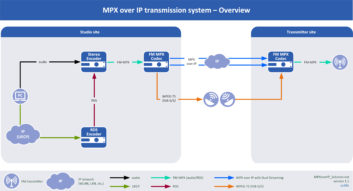The author is sales and marketing manager at 2wcom.

Time has flown since the introduction of IP, and today, even most rural regions are connected to the internet. In addition, the cost has shifted in terms of satellite and IP bandwidth, even if it varies from country to country.
With this in mind, MPX over IP offers radio stations operating a VHF network the possibility to choose their best transmission approach, depending on coverage and costs. This results in significantly more possibilities for signal distribution, leading to increased flexibility in network management.
Some general points and main advantages:
- The technology offers potential of savings in terms of bandwidths costs. If satellite is not economical, especially if the required kbps increases due to a high number of individual RDS configurations, plain MPX over IP is the cost-saving alternative. The situation is completely different when distribution via IP is a cost driver. Then encapsulation of the MPX signal in a transport stream for satellite distribution is the economic way to go. System simplification is possible because studio and transmitter locations are directly connected and the multiplex signal is only generated at the studio site. Two scenarios are given for signal generation.

Scenario 1: A complete multiplex signal consisting of mono, stereo, pilot and RDS is transmitted to the regional transmitter sites.
Scenario 2: The multiplex signal consists only of mono, stereo and pilot. The RDS signal is generated for regionalization at the local transmitter sites.
- In the best case (scenario 1), users can dispense with a sound processor, RDS encoder and stereo generator at transmitter sites. This reduces purchase and energy costs and means less effort is required to maintain the system and the minimization of failure points.
- When digitizing the signal, it is possible to adjust transmission bandwidth configurations, according to audio quality and bandwidth requirements. The signal bandwidth and the resolution of the digitized MPX signal are crucial for the quality. However, most transmitters already achieve very good quality with a signal-to-noise ratio (SNR) > 70 dB.
- For synchronization, it is recommended to use the Pulse Per Second (1PPS) signal derived from GPS. In combination with a 10 MHz clock, synchronization of all receivers in a network is possible. Requirements: The total delay must be greater than the longest transmission time between the encoder and a transmitter location, but less than 1 second (≤ 900 milliseconds). This compensates the effects of runtime differences of the various transmission types and simplifies mixed operation (IP/satellite). To allow 1pps synchronisation, especially for VHF single-frequency network (SFN), it is indispensable to choose MPX via IP distribution because audio, ancillary data and pilot tone must be distributed as one signal. If capacity is not an issue, the network operator can also centralize system monitoring. Special receivers equipped with multiplex for monitoring and controlling output can be used to rebroadcast the signal for monitoring. In addition, it can be stored for future reference. Due to stringent regulatory requirements for MPX distribution, more complex monitoring devices offer precise measurement parameters for MPX signal peak deviation and power.
 IP Packet Handling
IP Packet Handling
General problems like IP packets in the wrong order (packets were sent over different routes), packet jitter or even duplicate packets should be solved by a larger buffer and intelligent buffer management.
[Read: IBC Exhibitor Viewpoing: Werner Drews, 2wcom]
Mechanisms need to be available to deal with potential packet losses caused by transport failures or incorrectly configured routers/switches. This is important because the UDP [User Datagram Protocol] normally used in these situations only supports sending IP packets, not re-requesting of lost packets. The following mechanisms can be used to tackle this problem:
- For cable and DVB network using MPEG-TS: A proven mechanism is the Pro-MPEG error protection, which can also be chosen for other data types. The error protection is based on the fact that sent packets are organized in a matrix structure at the encoder in order to calculate correction packets over the rows and columns.
- An alternative for IP networks: In this case, the RUDP [Reliable User Datagram Protocol] can guarantee reliable IP packet delivery even with very high packet losses. It protects against random packet losses as well as burst packet losses. In addition, RUDP requires less bandwidth and shorter delay times than conventional forward error correction mechanisms, such as Pro-MPEG FEC. (Note: RUDP needs a duplex IP link and unicast/multiple unicast.)
If bandwidth economy does not play a role, MPX over IP codecs that offer dual streaming can be used to increase transmission robustness. If the primary stream is interrupted, the decoder switches to the second stream. Furthermore, a redundant setup including cable and satellite can ensure distribution of the MPX signals.
CONCLUSION
MPX over IP offers broadcasters three major advantages.
First, by directly connecting the studio and transmitter site, the equipment required is reduced, resulting in less time and money spent on system support.
Second, the technology distributes the multiplex signal in excellent quality, while hardware and software redundancy ensures transmission robustness.
Last, operators can utilize respective technology for distribution, which offers the best bandwidth economy as well as optimal regional coverage.






